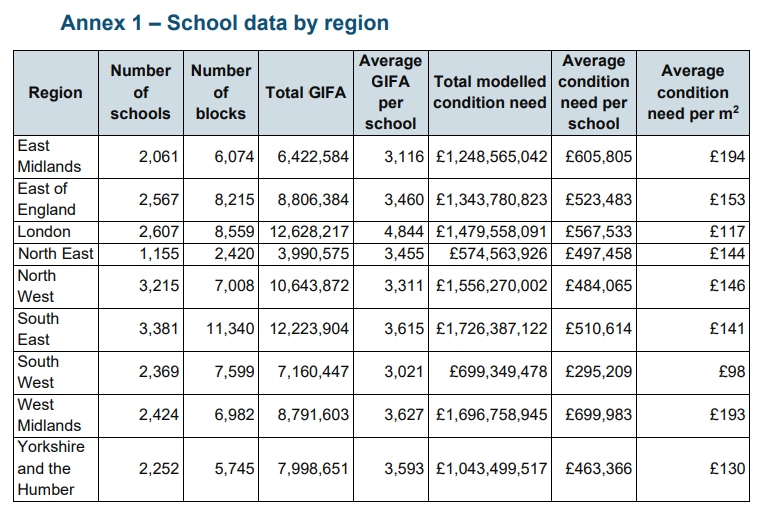
The cost of remedial work to repair or replace all defective elements in the school estate in England has risen to £11.4bn, a group of consultants has found.
The Department for Education’s latest Condition of School Buildings Survey, produced by Aecom, Capita, Faithful+Gould and RLB, collected data on 22,031 schools across nine geographical regions of England. The work involved 300 building surveyors and engineers collecting condition data at any one time.
Data collected included summary asset data about a school’s size and construction type, an assessment of the condition of each building, and management data such as electrical and fixed wiring test certificates and fire risk assessments.
The cost of repairs to England’s schools has risen significantly on the £6.7bn estimated to be required in the National Audit Office’s 2017 report on schools capital, based on data from the 2012-14 Property Data Survey for the Department for Education.

Schools in the South East and West Midlands each have £1.7bn of condition need, the highest in the state. Schools in the North East have the lowest total condition need, with below £600m.
Schools in the West Midlands have the highest average condition need per school at over £700,000 and the second highest condition need per m2 at £193/m2. The only region with a higher condition need per m2 is the East Midlands, at £194/m2. Most regions have similar condition needs per m2 throughout their schools, with East of England, North East, North West, South East and Yorkshire and the Humber all being between £130/m2 and £153/m2.
The regions with the lowest condition need per m2 are London, with £117/m2 and the South West with £98/m2, the only region with a condition need below £100/m2.
For teaching blocks still being used in the school estate, the 1960s is the decade with the largest representation in terms of available floor area, and is over 4,000,000m2 and over 50% greater than the decade either side of it. The two decades in the 21st century are the next highest for available floor area.
Comments
Comments are closed.











I am a building surveyor but have been retired for ten years. I was involved in a similar data gathering exercise during my career An enormous sum has already been spent on condition surveys but a completely inadequate sum has been spent on the huge backlog of repairs or replacements.
Hopefully the £11.4bn represents the costs of all of the items within the surveys not just where the buildings fall into condition C & D as a whole. If this is not the case the total is being wildly under estimated.
Yet again the cry “Our crumbling schools!” appears in the media. Nobody has ever asked how this situation came about or how to put it right. These programmes are a waste of time unless their maintenance is properly managed. Supervision is minimal and there is rarely any management oversight of what is being done. As a result the same things are repaired again and again when they could be replaced for a fraction of the cost.
I took over an estate of 100+ assorted schools in 1979 where the buildings were leaking like sieves and some were literally falling apart. The problem was only partly funding but the main problem was no one was organising their maintenance and such work that was being done was left to the initiative of individual tradesmen. To give one instance the method of repairing a flat roof was simply pour bitumen over the general area and spread it with a brush. Just by having an inspector oversee these repairs we reduced costs by over 60% – in addition to actually stopping the leaks.
If you think things have changed, 15 years ago I had the frustrating experience of a Victorian school that needed extensive repairs to the brickwork. You could stick your fingers into the gaps up to a second joint in places but there was no money for brickwork repair. There was however £60,000 as part of some great government “Initiative” for the quite unnecessary replacement of the railings and the construction off flower boxes and play equipment. These were improvements but most would have thought keeping the rain out and plaster on the classroom walls had a higher priority.
Until the 1990s one of the purposes of School maintenance budgets was to support councils own direct labour departments. I discovered that the parks Department was charging 300% over market price for cutting the grass on playing fields. When I pointed out this money would be better spent on the buildings I was politely told to shut up.
It was to frustrate this the Thatcher government took the money from councils and gave it to schools which was no real improvement because teachers with no construction experience were given budgets of up to £50,000pa to manage.
The problem is that the day-to-day management of school maintenance is considered so trivial it is beneath the dignity of professionals while acting on the information it provides of what is going on and what needs to be done is beyond the capacity of the management to whom it usually falls
The Times Educational Supplement published a couple of my papers the subject in the 1990’s but when I tried to explain what was necessary to a journalist on the national press at the time it was dismissed as “Just a lot of boring detail”
Well it’s high time somebody gave a little attention to the boring details of what is being done and how money is being spent. The situation is bad but “initiatives” and other political meddling over 25 years has made things worse.